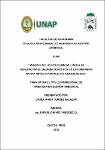Análisis del uso de biomasa leñosa en generación de energía doméstica en la Comunidad Nativa Hipólito Unanue río Amazonas 2021
Abstract
The work was developed in the Native Community of Hipólito Unanue (he/she Laughs Amazons) in Loreto, with the objective of evaluating the current situation of the use of woody biomass to generate domestic energy, the study was descriptive Not Experimental, the Quasi-experimental design, the population was conformed by all the families of the community, the sample was conformed by 30 people. To complete the objectives the descriptive statistic it was not used parametric, tests of Half central tendency, Fashion and tests of X2, ending up concluding: The forms of generating energy in the Community are through the coal and of the firewood, 40 housings use the firewood (44,4%), 24 housings the coal, 18 use (firewood and coal) and 8 housings use gas, the daily consumption of firewood goes from (3 to 7 kg/día), in a same way the coal (5 to 6 kg), but these non-alone materials are used in the housings, but rather also in its great majority they are marketed third people. The 54,4 (49 people) they say to extract this resource of the Center of the forest, 21,1% (19 people) of their same lands, 18,9% (17 people) they extract it of the communal forest and 5,6% (5 of them) they buy it to third people, the time that the resident takes to look for and to bring this resource is of 5 hours (33,3%), the used species are: (Capirona, Guaba, Wading caspi, Pashaco, Machimango, Huacapurana, Shimbillo, Rifari; among other), it is observed that to the moment to knock down the tree not to keep in mind any aspect to be used as firewood and coal, regarding the outlined hypothesis this it is accepted the extraction since it is untenable and it affects to the local forests of the Native Community. El trabajo se desarrolló en la Comunidad Nativa de Hipólito Unanue (Rio Amazonas) en Loreto, con el objetivo de evaluar la situación actual del uso de biomasa leñosa para generar energía doméstica, el estudio fue descriptiva No Experimental, el diseño Cuasi-Experimental, la población estuvo conformada por todas las familias de la comunidad, la muestra estuvo conformada por 30 personas. Para cumplir los objetivos se utilizó la estadística descriptiva no paramétrica, pruebas de tendencia central Media, Moda y pruebas de X2, llegando a concluir: Las formas de generar energía en la Comunidad son a través del carbón y de la Leña, 40 viviendas utilizan la leña (44,4%), 24 viviendas el carbón, 18 usan (leña y carbón) y 8 viviendas usan gas, el consumo diario de leña va desde (3 a 7 kg/día), de igual manera el carbón (5 a 6 kg), pero estos materiales no solo son utilizados en las viviendas, sino que también en su gran mayoría son comercializadas a terceras personas. El 54,4 (49 personas) dicen extraer este recurso del Centro del bosque, el 21,1% (19 personas) de sus mismos terrenos, el 18,9% (17 personas) lo extraen del bosque comunal y el 5,6% (5 de ellos) lo compran a terceras personas, el tiempo que tarda el poblador para buscar y traer este recurso es de 5 horas (33,3%), las especies más utilizadas son: (Capirona, Guaba, Zancudo caspi, Pashaco, Machimango, Huacapurana, Shimbillo, Rifari; entre otras), se observa que al momento de tumbar el árbol no tener en cuenta ningún aspecto para ser utilizados como leña y carbón, respecto a la hipótesis planteada esta se acepta ya que la extracción es insostenible y afecta a los bosques locales de la Comunidad Nativa.
Collections
- Tesis [501]


